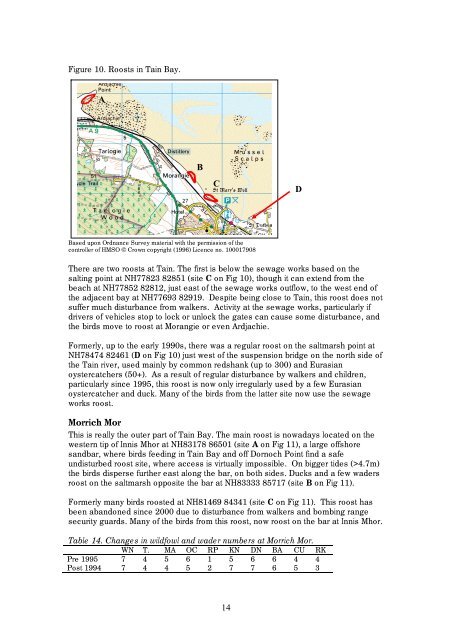Commissioned Report 252 - Scottish Natural Heritage
Commissioned Report 252 - Scottish Natural Heritage
Commissioned Report 252 - Scottish Natural Heritage
You also want an ePaper? Increase the reach of your titles
YUMPU automatically turns print PDFs into web optimized ePapers that Google loves.
Figure 10. Roosts in Tain Bay.<br />
A<br />
Based upon Ordnance Survey material with the permission of the<br />
controller of HMSO © Crown copyright (1996) Licence no. 100017908<br />
There are two roosts at Tain. The first is below the sewage works based on the<br />
salting point at NH77823 82851 (site C on Fig 10), though it can extend from the<br />
beach at NH77852 82812, just east of the sewage works outflow, to the west end of<br />
the adjacent bay at NH77693 82919. Despite being close to Tain, this roost does not<br />
suffer much disturbance from walkers. Activity at the sewage works, particularly if<br />
drivers of vehicles stop to lock or unlock the gates can cause some disturbance, and<br />
the birds move to roost at Morangie or even Ardjachie.<br />
Formerly, up to the early 1990s, there was a regular roost on the saltmarsh point at<br />
NH78474 82461 (D on Fig 10) just west of the suspension bridge on the north side of<br />
the Tain river, used mainly by common redshank (up to 300) and Eurasian<br />
oystercatchers (50+). As a result of regular disturbance by walkers and children,<br />
particularly since 1995, this roost is now only irregularly used by a few Eurasian<br />
oystercatcher and duck. Many of the birds from the latter site now use the sewage<br />
works roost.<br />
Morrich Mor<br />
This is really the outer part of Tain Bay. The main roost is nowadays located on the<br />
western tip of Innis Mhor at NH83178 86501 (site A on Fig 11), a large offshore<br />
sandbar, where birds feeding in Tain Bay and off Dornoch Point find a safe<br />
undisturbed roost site, where access is virtually impossible. On bigger tides (>4.7m)<br />
the birds disperse further east along the bar, on both sides. Ducks and a few waders<br />
roost on the saltmarsh opposite the bar at NH83333 85717 (site B on Fig 11).<br />
Formerly many birds roosted at NH81469 84341 (site C on Fig 11). This roost has<br />
been abandoned since 2000 due to disturbance from walkers and bombing range<br />
security guards. Many of the birds from this roost, now roost on the bar at Innis Mhor.<br />
Table 14. Changes in wildfowl and wader numbers at Morrich Mor.<br />
WN T. MA OC RP KN DN BA CU RK<br />
Pre 1995 7 4 5 6 1 5 6 6 4 4<br />
Post 1994 7 4 4 5 2 7 7 6 5 3<br />
B<br />
C<br />
14<br />
D

















